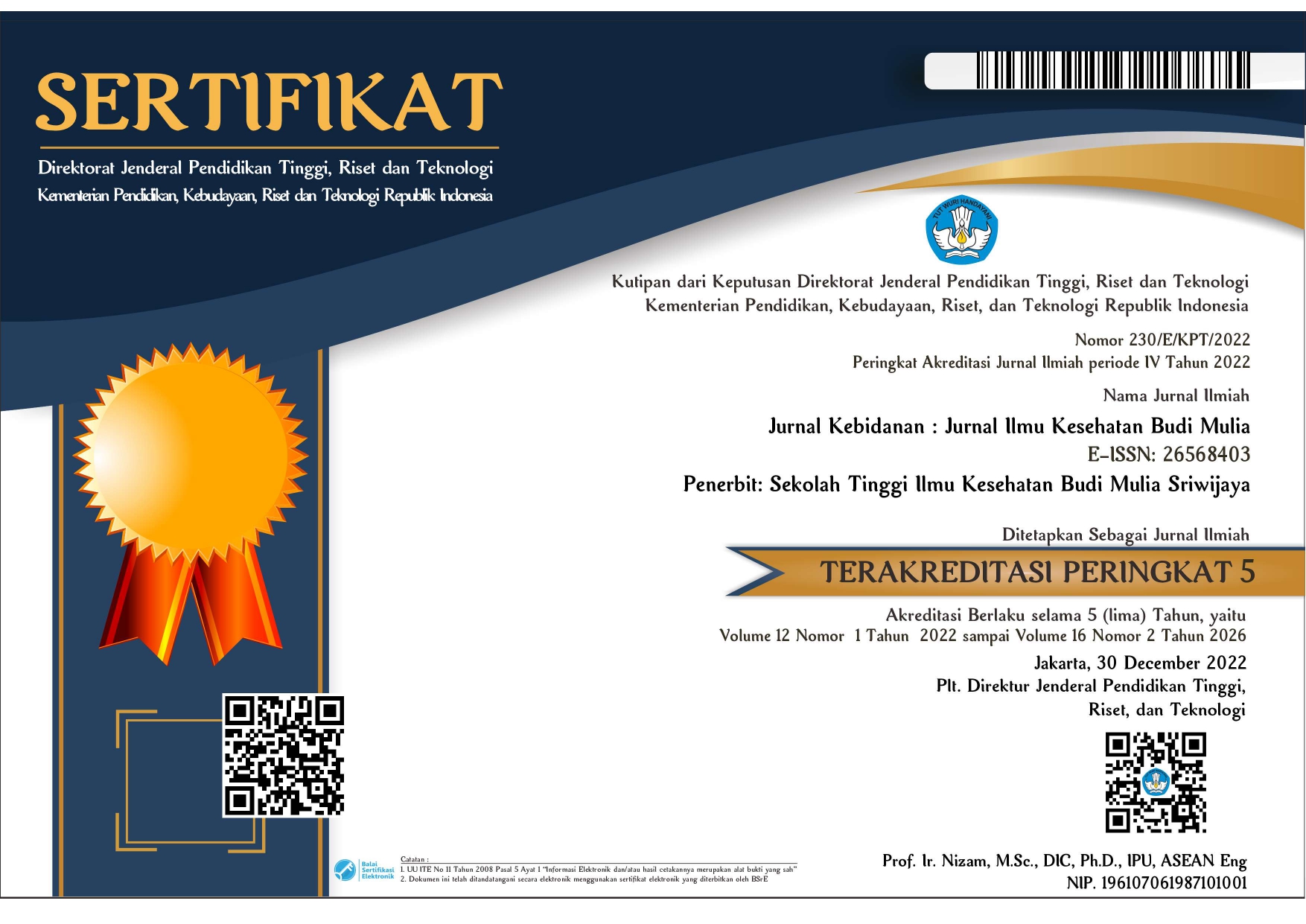ANALISIS DETERMINAN PENGGUNAAN ALAT KONTRASEPSI DALAM RAHIM DI RUMAH SAKIT MUHAMMADIYAH PALEMBANG TAHUN 2014
Abstract
ABSTRAK
Penggunaan AKDR masih tergolong rendah, padahal banyak sekali keunggulan AKDR yakni sebagai alat kontrasepsi yang efektif mempunyai angka kegagalan rendah yaitu terjadi 1-3 kehamilan/100 perempuan (akseptor). Tujuan penelitian diketahuinya faktor determinan yang mempengaruhi penggunaan Alat Kontrasepsi Dalam Rahim (AKDR) di Rumah Sakit Muhammadiyah Palembang Tahun 2014. Desain penelitian ini cross sectional, populasinya seluruh akseptor KB di Rumah Sakit Muhammadiyah Palembang Tahun 2013, yaitu berjumlah 384 akseptor. Metode pengambilan sampel dengan teknik accidental sampling sebanyak 88 responden. Pengumpulan data menggunakan kuesioner. Analisis data bivariat dengan chi square dan analisis multivariat menggunakan uji regresi logistik. Hasil penelitian menunjukkan ada hubungan antara faktor umur (p value 0,001), faktor pendidikan (p value 0,005), faktor paritas ( p value 0,004), faktor pendapatan (p value 0,004), faktor keyakinan (p value 0,011), faktor budaya dengan (p value 0,020), faktor dukungan suami (p value 0,002), dan faktor pengetahuan (p value 0,005) dengan penggunaan AKDR. Analisis multivariat didapatkan dukungan suami yang menjadi faktor dominan dalam penggunaan AKDR dengan OR (odds ratio) 7,047 dan kontribusi dukungan suami terhadap penggunaan AKDR adalah 24,28%. Bagi Rumah Sakit disarankan perlunya peningkatan konseling pra pemasangan dan pasca pemasangan AKDR, serta keterlibatan yang lebih besar dari petugas KB perempuan dalam setiap pelayanan AKDR. Selain itu peningkatan partisipasi suami bukan hanya dengan memberikan dukungan kepada istrinya untuk menggunakan kontrasepsi AKDR tetapi dapat menjadi peserta KB secara langsung. Bagi Akademi Kebidanan Rangga Husada agar lebih memfasilitasi atau memperbanyak referensi di perpustakaan khususnya tentang penulisan ilmiah dan metodelogi penelitian, sehingga dapat menambah pustaka dan keilmuan. Bagi Peneliti selanjutnya disarankan untuk meneliti dengan menggunakan pendekatan kualitatif untuk menggali alasan rendahnya peminat akseptor menggunakan AKDR.
ABSTRACK
The use of IUD is still relatively low although it has a lot of advantages. For instance, the IUD is an effective contraceptive which has a low failure rate, occurred 1-3 pregnancy/100 acceptor women per year. This study aims to determine the factors affecting the use of an intrauterine device (IUD) in Muhammadiyah Hospital Palembang in 2014. It was a cross-sectional study with 384 populations taken from the entire family planning acceptors in Muhammadiyah Hospital Palembang in 2013. The accidental sampling technique was used to get 88 respondents. The data were obtained by means of a questionnaire. Bivariate analysis was performed by using chi square and multivariate analysis was performed by using logistic regression. The result of the study indicates that there is a correlation among the age factor ( p value 0,001) education factor (p value 0,005), parity factor (p value 0,004), income factor (p value 0,004), confidence factor (p value 0,002), and culture factor ( p value 0,005) and the use of IUD (Intrauterine Device). Multivariate analysis was obtained from the husband’s support which becomes the dominant factor in using the IUD (Intrauterine Device) with OR (odds ratio) 7,047 and the contribution of the husband’s support in Using the IUD (Intrauterine Device) is 24,28 %. Hospital is suggested to increase the counseling of pre and post IUD insertion, have the greater involvement from the women staff in all IUD services. Besides, the increased participation of husband is not only by providing support to his wife to use the IUD but may become the family planning participant directly. Academy of Midwifery Rangga Husada is to add more facilities and library references especially in terms of scientific writing and research method so that it can increase the scientific literature and knowledge. For further research, it is recommended to do the research by the use of a qualitative approach to explore the reason for the low interest in using the IUD acceptors.











